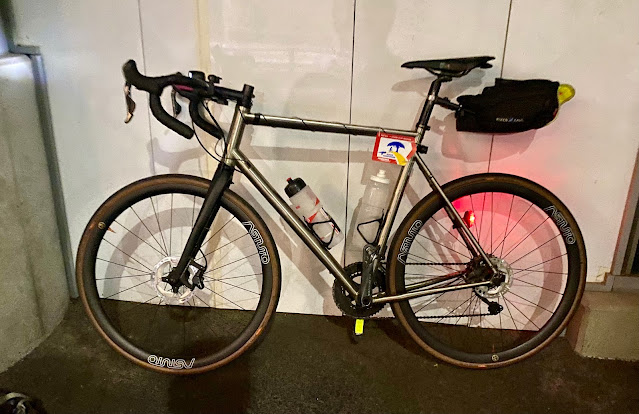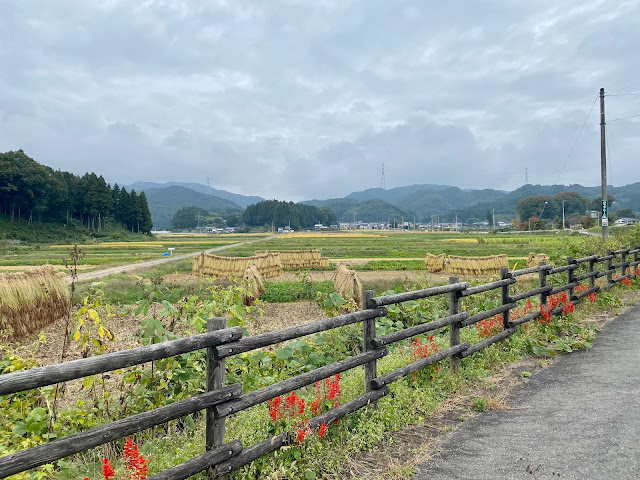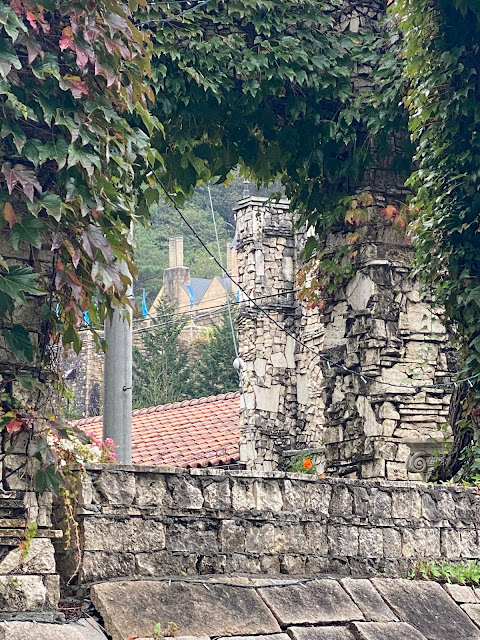 |
| Moon rises over Ibaraki |
On Saturday, December 10, I joined the Saitama Audax 300km "Attack Nakagawa" brevet.
I need to do a full SR series (200/300/400/600km official brevets) to qualify for Paris-Brest-Paris (PBP) next summer. I signed up for this event during my US trip last month, but was actually planning to skip it and instead do a 300km Randonneur Tokyo event in January, as it turned out that I had a bonenkai scheduled for yesterday.
... But the Randonneur Tokyo event filled up within an hour or two of registration opening and I missed my chance to sign up. Also, the weather forecast for Saturday looked ideal for an early winter ride. And I really felt the need for a decent endurance ride after several months of travel and abstinence from long-distance cycling. Strava tells me that my conditioning has dropped dramatically due to lack of activity over the past six weeks. My body does not dispute that. I've gained weight and lost muscle. So I went ahead with the ride, skipping the bonenkai.
Like many Saitama Audax events, it started from Toyomizu Bridge at the Iruma River, where it is easy to park a car for a day or two, and the organizers can set up shop under the bridge to sign-in riders and manage the "goal" without need for a tent or fear of rain. The route headed generally north and east, to Nakagawa (那珂川) in NE Tochigi Prefecture, then back again.
 |
| No trolls under the bridge at Toyomizubashi in Iruma. |
The forecast suggested weather would be in between roughly 3 and 14 degrees celsius during the ride. It would be coldest at the start and again toward the finish after dark. But there were no mountain passes and would be no frost nor ice. I made do with a short sleeve jersey and bib shorts, Craft windblock inner layer, arm and leg warmers, double socks (thin inner and wool outer), and my Q36.5 Amfib gloves. I brought a second pair of gloves for the warmer part of the day (which, in a pinch, I could slide on top of the Amfibs if I needed more warmth in the coldest hour -- I did not). And I packed a lightweight helmet-lining balaclava, shoe covers, and a thin/light rain shell just in case. I find the arm and leg warmers are unbeatable for this type of conditions ... winter bib shorts or a long-sleeved fleece lined jersey will feel great the first hour of cold, but will have you dripping sweat as you ride in the mid-day sun.
The route to "Attack Nakagawa"
I was very pleased with the rest of the weather forecast. No worries about precipitation. And no strong winds. I can remember struggling on plenty of previous brevets north of Tokyo in vicious headwinds ... at their worst in Spring.
I have really been enjoying the RAMAX, with the wide hookless rim wheels from GS Astuto and my Schwalbe Pro One 700x32 tubeless tires, and was eager to ride it to see how fast it was on this type of course.
 |
| RAMAX rests at PC1 |
Anyway, I was at the start in time for the 630AM briefing and to head out a few minutes before 7AM. Within a few hundred meters of departure, I was following two other riders who were going at a relaxed pace. Within a kilometer, someone zoomed by, riding in a massive gear. I did not try to follow. But we caught him soon at a red light. This ride had lots of red lights. I think the organizers tried to avoid lights where they could ... but it is hopeless. There were more red lights on this route than convenience stores. By the time we got to this red light, we had passed at least two Seven Elevens and one Family Mart that I recall, and doubtless others. And this was our third red light. All in just over a kilometer.
When we left the red light, I passed the relaxed riders and stayed with Mr. Massive Gear. I got a nice pull for awhile, and within another kilometer or two we caught (and were joined by) another rider, probably my age or a few years older, riding a Trek Domane. Both these riders were going hard enough that I could not really pull much, but was just along for the ride. I managed to hang with them, occasionally dropping back but catching up at a red light. We were joined by two other riders. Eventually the Trek rider dropped back, and the two others started to lead ... until they missed a left turn. I was riding 4th of 4 and yelled (and stopped) as soon as we passed the turn. It took them another 50+ meters to stop. Meanwhile, the rider on the Trek Domane had made the turn, ... and I was back and around the corner.
So the ordering of our group was reversed, strongest riders at the back, probably one traffic signal behind. Eventually I caught the Trek rider, and we were passed by Mr. Massive Gear. They went ahead, and the two buddies who had missed the turn caught me. I would see the Trek Domane rider again at some PCs ... but not Mr Massive Gear, who presumably finished well ahead. I slotted in behind the two who had missed the earlier turn. We stopped at another red light, where the course turned left. I made a lame joke about making sure to catch the turns. At one point I asked how far it was to PC1. I remembered there was only a single PC while traveling in each direction, plus the turn-around, but not the location. Somehow I thought it was a 72kms in. ... they told me it was at 89kms. I would need another quick convenience store break to make it there.
 |
| Typical rest stop view ... dining in front of a Seven Eleven |
So I took a quick bathroom break and bought a snack at ... a Seven Eleven, then found myself back on the road in a train of around 5 riders. One had "Sugiura" on the back of his reflective vest. Actually nice to have a name prominently placed like that. Anyway, two of the riders dropped off, more joined, and I was able to hang with them for another long stretch.
The point of recounting all this detail is to convey that I could ride with others, mostly drafting and occasionally pulling, all the way to PC1 at 89kms. The PC was a "quiz point" about the statute/memorial at a park entrance, but many riders had gathered and were resting across the road ... at a Seven Eleven. I pushed on to 120kms, where I stopped, at a Seven Eleven, for a first lunch break, of convenience store spaghetti napolitano. The sauce was orange, very close to the color of my jersey. I could not help but think that the stain might not be visible if I spilled sauce on the jersey as I ate, sitting on the ground outside the store.
 |
| PC1 - the tent is not for Audax. Most riders rested across the way at a Seven Eleven. |
 |
| PC1 quiz involved this object |
Up to now, I had not taken out my camera once as we rode. The scenery ... typical Japanese sprawl, just did not seem to offer any photo that I have not already taken before, many times. The red lights were a nuisance, but offered a chance to rest at regular intervals. But I did notice the truck exhaust in places. I could see that a layer of smog hung over the northern Kanto plains, and I began to regret the lack of much wind. There were plenty of trucks on Saturday morning, and I could notice the diesel exhaust in places. I felt as if I could taste the particulate and feel a bit of grit forming on my teeth even. Later in the afternoon, I felt a bit of a sore throad, I am pretty sure from the same pollution. And as dusk appeared, I could see a bit of dust and particles in the beam of my headlight. Overall, not great air quality on the first leg of the ride, or going over the same segment late afternoon.
The environment seemed to improve markedly after we entered Tochigi and swung to the East of Utsunomiya through Moka, Haga, and Nasukarasuyama. The area felt less like suburban sprawl and more like nice countryside. There was even a hilly section. And the air quality felt better -- the wind had picked up a bit, though it was still not strong, and was usually not directly ahead or behind us.
 |
| Crossing the Nakagawa just south of Nakagawa |
At the turn around PC, I rested but did not eat much. An onigiri and yogurt drink. I headed out and ... felt good. In fact, I felt great. My body had adjusted to the riding position, my digestion was working well, and fatigue had not set in. I was with some other riders on the hilly section, but pushed ahead after most of the climing was done. I tried to alternate between riding on the bar hoods and in the drops. The more aero position of the drops would boost my speed noticeably. And the RAMAX has a somewhat higher front end than a racing bike, so even when I am in the drops, the position is not that aggressive, and I can hold it for some time without stressing my back.
 |
| Scenery at the turn around PC |
We were on plenty of roads that had rough surfaces, especially along the outer edge where we needed to ride. I really appreciated riding 700x32 tires with around 60-65psi air pressure. This gear selection limited the wear and tear on my body. I found that my hands would stay comfortable on the bumpier sections in 3 out of the 4 hand positions that I used regularly. So I would avoid the 4th position on rougher roads.
At 200 kms I stopped for omu-rice (omelet rice) dish at a Family Mart. I could eat inside, sitting at the Famima Cafe. I had ridden the first 200km at 9hrs and 31 mins (including rests). That is fast for me, for a brevet. On a normal Japan Audax course, usually I will do a 200km brevet in 10-11 hours. The super-hilly Nishi Izu brevet in March took me 12 hours. My fastest 200km brevet was 8hrs and 20 mins (officially 8hrs 40mins as I arrived late to the start) ... That was also a winter event in flat northern Kanto, back in 2014.
 |
| Omu-rice |
After 200km, I still felt ... really good. Nothing hurt, no serious fatigue, and I could modulate my speed well by changing positions. I rode with a few other riders ... but mostly I rode past others.
I continued to make good time to another stop, at the 251 kms PC, a Seven Eleven. I got a lasagna with meat sauce dish. Here I also could sit inside at a counter with chairs. It was now well after dark. The temperature had dropped, and the cold air felt ... really good. Bracing. It kept me alert. My only adjustments had been to pull up my arm warmers so that my arms were full covered, and to switch back from my thin midday gloves to my much warmer Amfib ones.
 |
| Lasagna with meat sauce |
As I continued, I caught a rider and drafted for awhile ... until I passed him and gradually pulled away. Once I was in the drops, my speed would creep up and ... he could not hold on. Eventually, a rider did pass me, on a Cannondale, and I jumped on behind him. We were relatively evenly matched and took turns pulling. .... until he pulled off to rest at the bottom of an incline to a bridge over a river, motioning me to continue on. The last 15 kms to the finish, I was entirely alone, everyone either well ahead or behind me. I finally started to feel some fatigue and my pace slowed, but I knew I just had to keep rolling. I rolled in to the goal at 9:57PM, for a time of 14 hrs and 57 mins.
 |
| At the goal. |
Epic? Not really. But a good ride.
Actually, my fastest previous Audax 300km was back in 2014, at 14 hrs and 59mins. It was another flat winter route, with even more traffic signals and heavier traffic, as I recall. This one was better. And I was very pleased to complete within 15 hours, despite plenty of rest stops.
At the goal, I checked in, chatted with Sugata-san, the organizer (if I have his name right), then Tak Kawano emerged from the shadows, already changed out of cycling gear. He had done the 6AM start, I learned. (they don't post entry lists anymore, so I did not know he was doing the event).
The cold hit me within a few minutes after I stopped exercising. In the end, I put on the balaclava, and sat near a kerosene stove, but was shivering nonetheless. So I heated up the inside of my car, planning to rest for a bit and warm up before heading home. After ten minutes, I was a bit warmer, and still alert and wide awake, so I made the one hour drive home, took a hot bath, and enjoyed a deep, post-brevet sleep.












































